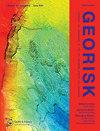基于风险的开挖工程设计的改进生命周期成本法
IF 4.8
3区 工程技术
Q1 ENGINEERING, GEOLOGICAL
Georisk-Assessment and Management of Risk for Engineered Systems and Geohazards
Pub Date : 2022-10-27
DOI:10.1080/17499518.2022.2101067
引用次数: 0
摘要
生命周期成本(LCC)设计方法试图在设计过程中使用不同的成本(如风险成本)来改进传统的设计方法。本文介绍了一种改进的全寿命周期成本法(MLCC)用于基坑设计。在典型的LCC设计方法中提出了一些修改,包括通过风险寻求因子考虑决策者在LCC主公式中的风险规避/寻求效应,以及通过风险持续时间作为影响因子考虑风险暴露时间对风险成本的影响。风险寻求因子是基于期望效用理论对决策者的风险行为进行识别得到的。风险持续时间影响因子是通过分析高风险挖掘相对于其寿命的统计信息来评估的。在实际的城市深基坑工程中对该方法进行了评价,结果表明该方法具有较好的设计适用性和较好的设计结果。本文章由计算机程序翻译,如有差异,请以英文原文为准。
The modified life cycle cost method for the risk-based design of excavation projects
ABSTRACT The life cycle cost (LCC) design method tries to improve conventional design practices with different costs, such as risk costs, over the life cycle of the structure in the design procedure. The present study introduces a modified life cycle cost (MLCC) approach for the design of excavations. Some modifications proposed in the typical LCC design method include considering the effect of risk aversion/seeking of decision-makers in the main LCC formula by a risk-seeking factor and taking in the effect of risk exposure time on risk cost by a risk duration as an impact factor. The risk-seeking factor is obtained by identifying the risky behaviour of decision-makers based on the expected utility theory. The risk duration impact factor is evaluated by analysing statistical information about high-risk excavations versus their lifetime. The novel MLCC design method is evaluated in real deep urban excavation projects and the method is applicable for design and yields sensible outputs.
求助全文
通过发布文献求助,成功后即可免费获取论文全文。
去求助
来源期刊
CiteScore
8.70
自引率
10.40%
发文量
31
期刊介绍:
Georisk covers many diversified but interlinked areas of active research and practice, such as geohazards (earthquakes, landslides, avalanches, rockfalls, tsunamis, etc.), safety of engineered systems (dams, buildings, offshore structures, lifelines, etc.), environmental risk, seismic risk, reliability-based design and code calibration, geostatistics, decision analyses, structural reliability, maintenance and life cycle performance, risk and vulnerability, hazard mapping, loss assessment (economic, social, environmental, etc.), GIS databases, remote sensing, and many other related disciplines. The underlying theme is that uncertainties associated with geomaterials (soils, rocks), geologic processes, and possible subsequent treatments, are usually large and complex and these uncertainties play an indispensable role in the risk assessment and management of engineered and natural systems. Significant theoretical and practical challenges remain on quantifying these uncertainties and developing defensible risk management methodologies that are acceptable to decision makers and stakeholders. Many opportunities to leverage on the rapid advancement in Bayesian analysis, machine learning, artificial intelligence, and other data-driven methods also exist, which can greatly enhance our decision-making abilities. The basic goal of this international peer-reviewed journal is to provide a multi-disciplinary scientific forum for cross fertilization of ideas between interested parties working on various aspects of georisk to advance the state-of-the-art and the state-of-the-practice.

 求助内容:
求助内容: 应助结果提醒方式:
应助结果提醒方式:


